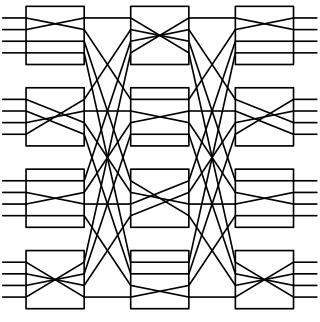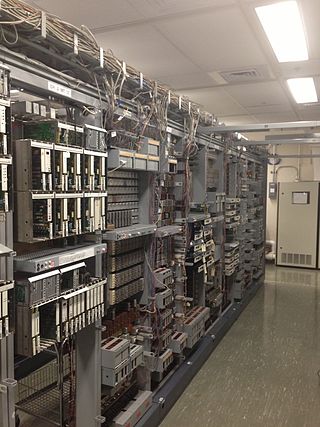
Bell Labs is an American industrial research and development (R&D) company, currently operating as a subsidiary of Finnish technology company Nokia. With a long history, Bell Labs is credited with the development of radio astronomy, the transistor, the laser, the photovoltaic cell, the charge-coupled device (CCD), information theory, the Unix operating system, and the programming languages B, C, C++, S, SNOBOL, AWK, AMPL, and others, throughout the 20th century. Eleven Nobel Prizes and five Turing Awards have been awarded for work completed at Bell Laboratories.

The 5ESS Switching System is a Class 5 telephone electronic switching system developed by Western Electric for the American Telephone and Telegraph Company (AT&T) and the Bell System in the United States. It came into service in 1982 and the last unit was produced in 2003.
Direct distance dialing (DDD) is a telecommunications service feature in North America by which a caller may, without operator assistance, call any other user outside the local calling area. Direct dialing by subscribers typically requires extra digits to be dialed as prefixes to the directory telephone number of the destination. International Direct Distance Dialing (IDDD) extends the system beyond the geographic boundaries of the North American Numbering Plan (NANP).
In telecommunications, an electronic switching system (ESS) is a telephone switch that uses solid-state electronics, such as digital electronics and computerized common control, to interconnect telephone circuits for the purpose of establishing telephone calls.
Telephony is the field of technology involving the development, application, and deployment of telecommunications services for the purpose of electronic transmission of voice, fax, or data, between distant parties. The history of telephony is intimately linked to the invention and development of the telephone.

In electronics and telecommunications, a crossbar switch is a collection of switches arranged in a matrix configuration. A crossbar switch has multiple input and output lines that form a crossed pattern of interconnecting lines between which a connection may be established by closing a switch located at each intersection, the elements of the matrix. Originally, a crossbar switch consisted literally of crossing metal bars that provided the input and output paths. Later implementations achieved the same switching topology in solid-state electronics. The crossbar switch is one of the principal telephone exchange architectures, together with a rotary switch, memory switch, and a crossover switch.

A nonblocking minimal spanning switch is a device that can connect N inputs to N outputs in any combination. The most familiar use of switches of this type is in a telephone exchange. The term "non-blocking" means that if it is not defective, it can always make the connection. The term "minimal" means that it has the fewest possible components, and therefore the minimal expense.
Call waiting is a telephone service where a subscriber can accept a second incoming telephone call by placing an in-progress call on hold—and may also switch between calls. With some providers it can be combined with additional features such as conferencing, call forwarding, and caller ID. Call waiting is intended to alleviate the need to have more than one telephone line or number for voice communications.
Transaction Language 1 (TL1) is a widely used management protocol in telecommunications. It is a cross-vendor, cross-technology man-machine language, and is widely used to manage optical (SONET) and broadband access infrastructure in North America. TL1 is used in the input and output messages that pass between Operations Support Systems (OSSs) and Network Elements (NEs). Operations domains such as surveillance, memory administration, and access and testing define and use TL1 messages to accomplish specific functions between the OS and the NE. TL1 is defined in Telcordia Technologies Generic Requirements document GR-831-CORE.
In computer networks, a network element is a manageable logical entity uniting one or more physical devices. This allows distributed devices to be managed in a unified way using one management system.

A business telephone system is a telephone system typically used in business environments, encompassing the range of technology from the key telephone system (KTS) to the private branch exchange (PBX).
Permanent signal (PS) in American telephony terminology, or permanent loop in British usage, is a condition in which a POTS line is off-hook without connection for an extended period of time. This is indicated in modern switches by the silent termination after the off-hook tone times out and the telephone exchange computer puts the telephone line on its High & Wet list or Wetlist. In older switches, however, a Permanent Signal Holding Trunk (PSHT) would play either an off-hook tone or a 480/500 Hz high tone. Off-hook tone is a tone of increasing intensity that is intended to alert telephone users to the fact that the receiver has been left off the hook without being connected in a call. On some systems before the off-hook tone is played, an intercept message may be announced. The most common message reads as follows; "If you'd like to make a call, please hang up and try again. If you need help, hang up and then dial your operator."

A marker is a type of special purpose control system that was used in electromechanical telephone central office switches. Switches employing markers belong to a class of switches known as "common control", as the purpose of a marker is to control the closure of contacts in the switching fabric that connect a circuit between the calling party and the called party. This is in contrast to "direct control" switches, where the switching elements were controlled directly by the customer's dial, such as the Step by Step switch. The term marker came from its use to mark a path of links through the switching fabric. A marker's comprehensive view of the switching fabric allowed it to find and assemble a path from one terminal to another, if the links were available, unlike the earlier graded progressive systems in which a path might not be found.
Stored program control (SPC) is a telecommunications technology for telephone exchanges. Its characteristic is that the switching system is controlled by a computer program stored in a memory in the switching system. SPC was the enabling technology of electronic switching systems (ESS) developed in the Bell System in the 1950s, and may be considered the third generation of switching technology. Stored program control was invented in 1954 by Bell Labs scientist Erna Schneider Hoover, who reasoned that computer software could control the connection of telephone calls.

The Number One Electronic Switching System (1ESS) was the first large-scale stored program control (SPC) telephone exchange or electronic switching system in the Bell System. It was manufactured by Western Electric and first placed into service in Succasunna, New Jersey, in May 1965. The switching fabric was composed of a reed relay matrix controlled by wire spring relays which in turn were controlled by a central processing unit (CPU).
Trunks Integrated Record Keeping System (TIRKS) is an operations support system from Telcordia Technologies, originally developed by the Bell System during the late 1970s. It was developed for inventory and order control management of interoffice trunk circuits that interconnect telephone switches. It grew to encompass and automate many functions required to build the ever-expanding data transport network. Supporting circuits from POTS and 150 baud modems up through T1, DS3, SONET and DWDM, it continues to evolve today, and unlike many software technologies today, provides complete backward compatibility. TIRKS was recently updated with a Java GUI, XML API, and WORD Sketch, which provides graphical views of the TIRKS Work Order Record and Details Document as well as SONET and DWDM networks. When TIRKS became a registered trademark in 1987, it became technically improper to use it as an acronym. TIRKS was one of many OSS technologies transferred to Bell Communications Research as part of the Modification of Final Judgment related to the AT&T divestiture on January 1, 1984. In the 1990s, the Facility and Equipment Planning System (FEPS) and Planning Workstation System (PWS) products were incorporated into the Telcordia TIRKS CE System. TIRKS is still in use at AT&T, Verizon, CenturyLink/Lumen Technologies, and altafiber.

Unix is a family of multitasking, multi-user computer operating systems that derive from the original AT&T Unix, whose development started in 1969 at the Bell Labs research center by Ken Thompson, Dennis Ritchie, and others. Initially intended for use inside the Bell System, AT&T licensed Unix to outside parties in the late 1970s, leading to a variety of both academic and commercial Unix variants from vendors including University of California, Berkeley (BSD), Microsoft (Xenix), Sun Microsystems (SunOS/Solaris), HP/HPE (HP-UX), and IBM (AIX).

A telephone exchange, telephone switch, or central office is a central component of a telecommunications system in the public switched telephone network (PSTN) or in large enterprises. It facilitates the establishment of communication circuits, enabling telephone calls between subscribers.
Operations support systems (OSS), operational support systems in British usage, or Operation System (OpS) in NTT are computer systems used by telecommunications service providers to manage their networks. They support management functions such as network inventory, service provisioning, network configuration and fault management.








